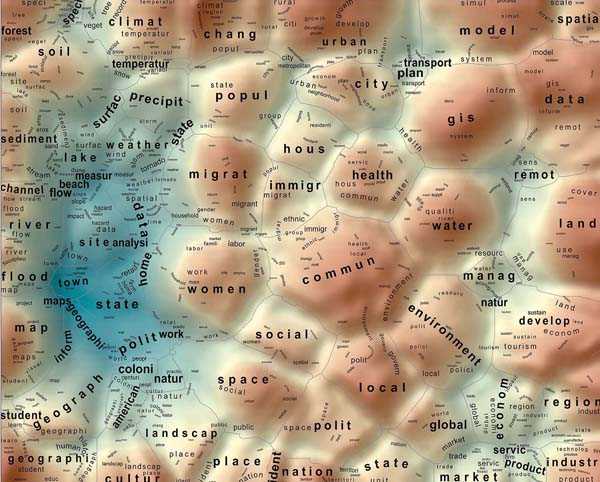CDC Museum to Host Places & Spaces: Mapping Science Exhibition
Drawing Actionable Insights from Data
This website is archived for historical purposes and is no longer being maintained or updated.
Media Statement
For Immediate Release: Monday, January 25, 2016
Contact: Media Relations,
(404) 639-3286

New CDC Museum Exhibit - Places & Spaces: Mapping Science
One of the many infographics found at the exhibit.
Data visualization is a powerful tool that helps both scientists and the public quickly understand the scope and context of complex health threats. From January 25 to June 17, 2016, the David J. Sencer CDC Museum will feature the Places & Spaces: Mapping Science exhibition showing how data visualization helps us confront some of the world’s most significant challenges.
Public health leaders need the best information to make better, faster decisions – and often need to communicate complicated health information that can save lives. Advances in maps, graphs, and other images can greatly help the public understand health threats and lead to quicker public health responses.
The Places & Spaces exhibition has collected science maps and visualization tools from leading international experts in the natural, physical, and social sciences, as well as from industry and government. By helping audiences grasp the abstract concepts, relationships, and dynamism of complex systems, the exhibition promotes more informed, effective decision making on the part of private individuals, industry practitioners, public policy makers, and others.
Subject Matter Experts
- Katy Börner, PhD, MS. Victor H. Yngve Professor of Information Science at Indiana University and Curator of the International Places & Spaces: Mapping Science – “In the information age, being able to ‘read and write’ data visualizations is becoming as important as being able to read and write text. The visualizations displayed in this exhibit showcase the power of data visualizations to save lives, to make decisions informed by high quality data, and to communicate the beauty and value of science to a general audience.”
- Robin Wagner, PhD, MS. Chief Science Officer for the Office of Public Health Scientific Services - “CDC uses maps to better understand patterns and relationships between environmental, social, and personal risk factors, and diseases and injuries over time and space. Visualizations can make it easier for CDC to take faster, better actions to protect the public’s health.”
- Andrew L. Dent, MA, MBA. Program Director for Geospatial Research, Analysis, and Services Program - “Since the emergence of public health, maps have been used to explore the intersection of place and health. Advances in technology and public health data collection have contributed to the development of increasingly sophisticated methods for analyzing and displaying data. Today, maps and data visualizations are essential in CDC’s efforts to prevent disease, prolong life, and promote health.”
Launch Event Details
CDC will host an Inaugural Lecture on Thursday, February 4, 2016, 5pm-6pm, followed by a reception at the David J. Sencer CDC Museum; and a Scientific Syposium on Friday, February 5, 2016; 1:30pm-4:30pm. Registration is required for the launch events.
Perspectives on Exhibition
- Louise E. Shaw, Curator, David J. Sencer CDC Museum – “Beautiful data visualizations - including maps, charts, graphs, and interactive displays — are being used to find meaning, reveal patterns, and reinforce messages as never before. The Places & Spaces exhibition proves data can be both actionable and artful.
Media Resources
- Places & Spaces: Mapping Science http://scimaps.org/.
- Places and Spaces Images #1- Similar Geographic Patterns of Health Outcomes, Risk Factors, and Economic Conditions, CDC. These maps highlight the similar geographic patterns of many health outcomes, risk factors, and socio-economic conditions in the U.S., underscoring the importance of place for the opportunities to live healthy lives.
- Places and Spaces Image #2-Impact of Air Travel on Global Spread of Infectious Diseases by Vittoria Colizza, Alessandro Vespignani and Elisha F. Hardy, 2007. These visualizations are based on models used to study epidemic spread pattern — in this case the impact of air travel. Detailed knowledge of worldwide population distribution and movement patterns of individuals by air travel is incorporated into the model to describe the spatio-temporal evolution of epidemics in our highly interconnected world.
- Places and Spaces Image #3- Maps from CDC’s Health Information for International Travel, 2016 commonly known as The Yellow Book. CDC Health Information for International Travel, better known as “The Yellow Book,” has been a trusted resource for travel health information since 1967. Published every two years, each new edition includes new maps.
- Places and Spaces Image #4- In Terms of Geography by André Skupin, 2005. This topic map was computed from more than 22,000 abstracts submitted to the annual meetings of the Association of American Geographers from 1993 to 2002.
Admission and parking are free, although parking may be limited. Visitors need a valid, U.S. government or state-issued photo ID. Vehicle inspection is required. The David J. Sencer CDC Museum is open Monday –Friday, 9:00 a.m. – 5:00 p.m., with extended hours to 7:00 p.m. on Thursday. The museum is closed on all federal holidays. For more information, visit the museum website: http://www.cdc.gov/museum/visitor.htm.
If you are interested in arranging an interview or would like additional information, please contact CDC Media Relations by phone (404) 639-3286 or email: media@cdc.gov.
- Page last reviewed: January 25, 2016 (archived document)
- Content source:
Error processing SSI file


 ShareCompartir
ShareCompartir